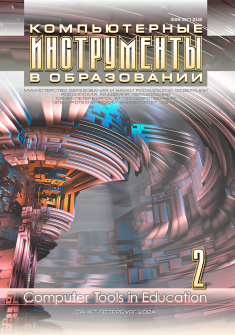Software Implementation for Construction of an Earth Satellite Orbit
Abstract
The work is devoted to the creation of a program that visualizes the dependence of the orbit of an artificial Earth satellite in near-Earth space on the values of its elements.T he process of unperturbed motion of the satellite is simulated. For greater clarity of the model, additional constructions are provided such as lines of apses, lines of nodes, equatorial plane, directions to the vernal equinox point. The influence of the nonsphericity of the Earth on the movement of an object is shown. The program is intended for use by students and teachers in full-time and remote modes.
References
N. P. Pupyrev, “Pedagogical capabilities of computer models,” Modern science-intensive technologies, no. 6, pp. 66–68, 2004 (in Russian).
O. S. Markovich, “Computer modeling in educational research: development of new teaching methods using information technologies,” Modern problems of science and education, no. 5, 2015 (in Russian).
M. Weigend, “Mathematical modeling and programming in natural science education,” Computer tools in education, no. 2, pp. 55–64, 2019 (in Russian); doi:10.32603/2071-2340-2019-2-55-64
E. I. Butikov, “Movement of cosmic bodies. Methodological materials for a complex of computer modeling programs,” in http://butikov.faculty.ifmo.ru, 2007. [Online] (in Russian). Available: http://butikov.faculty.ifmo.ru/MotionsRus.pdf
V. N. Aldokhina, S. V. Kulikov, and V. O. Korolev, “Model for predicting the movement of an artificial earth satellite in near-Earth space,” Modern science-intensive technologies, no. 1, pp. 7–11, 2021 (in Russian).
V. N. Aldokhina, V. O. Korolev, and R. V. Gudaev, “Visualization of the route of a space object in the LabVIEW programming environment,” in Collection of scientific papers “Problems of defense and security”, Moscow: Federal State Budgetary Institution “Expert Analytical Center”, no. 13b, pp. 106–111, 2015 (in Russian).
V. N. Aldokhina, V. O. Korolev, S. V. Kulikov, and D. S. Fedorenko, “Satellite orbit,” [Soft], Certificate of registration of the computer program RU 2020615106, 2020614119: declared 04/13/2020: publ. 05/15/2020.
P. Escobal, Methods for determining orbits, Moscow: Mir, 1970 (in Russian).
P. Eliasberg, Introduction to the theory of flight of artificial Earth satellites, Moscow: URSS, 2015 (in Russian).
J. Travis, LabVIEW for Everyone, Мoscow: DMK Press; PriborKomplekt, 2005 (in Russian).

This work is licensed under a Creative Commons Attribution 4.0 International License.







